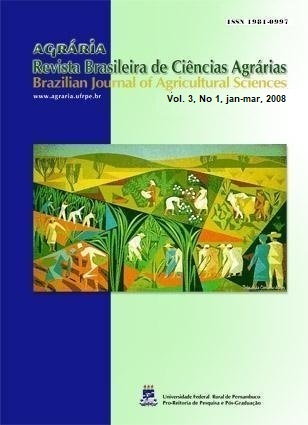Germinação do amendoim bravo (<i>Pterogyne nitens</i> Tul.) para utilização na recuperação de áreas degradadas
DOI:
https://doi.org/10.5039/agraria.v3i1a182Palavras-chave:
recomposição vegetal, uso do solo, crescimentoResumo
A espécie Pterogyne nitens Tul. pertence à família Leguminoseae - Caesalpinoideae, comumente conhecida como Amendoim Bravo; ocorre naturalmente entre as latitudes 06oS a 28o, é uma espécie secundária inicial, comportando-se como pioneira; ocorre em sítios arenosos e degradados e em solos de baixa fertilidade natural, é recomendada para plantios em reposição de matas ciliares em locais com inundações periódicas de rápida duração e recomposição e restauração de áreas degradadas.O estudo teve como objetivo definir o tipo de substrato e a temperatura mais adequada à germinação de sementes do Amendoim Bravo (Pterogyne nitens Tul) para servirem como espécie potencial na recuperação de áreas degradadas. Avaliaram-se os seguintes substratos: vermiculita, solo esterilizado e papel de filtro, nas temperaturas constantes de 20, 25, 30, e 35°C e alternada de 20-30°C no período de oito horas. O delineamento estatístico empregado foi o inteiramente casualizado (5 x 3), com quatro repetições de 100 sementes. A porcentagem de germinação e a velocidade de germinação, foram analisadas. Obtiveram-se os melhores resultados nas temperaturas constantes de 25, 30 e 35°C, e nos substratos vermiculita e solo.
Downloads
Downloads
Publicado
Como Citar
Edição
Seção
Licença

Este trabalho está licenciado sob uma licença Creative Commons Attribution 4.0 International License.


